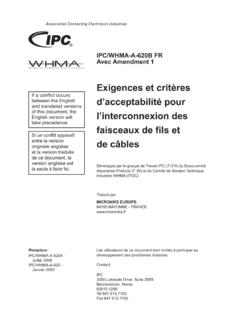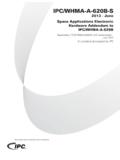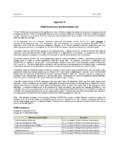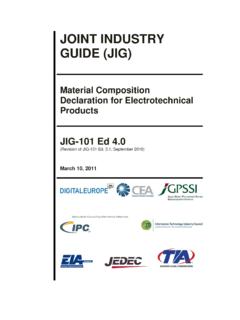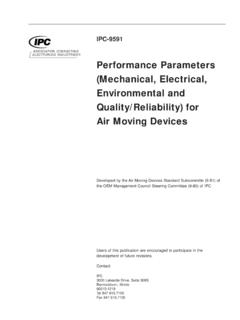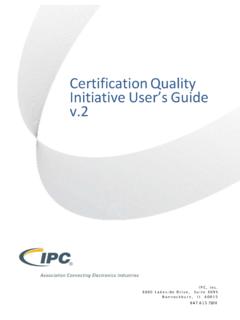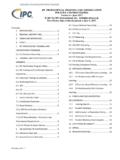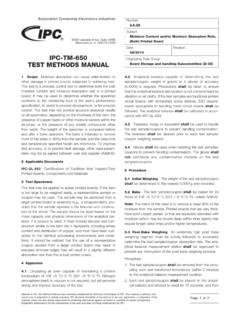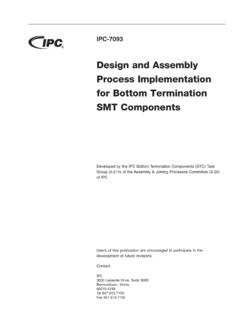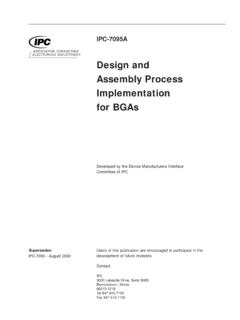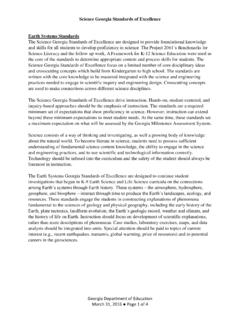Transcription of ASSOCIATION CONNECTING ELECTRONICS INDUSTRIES …
1 IPC-HDBK-830 Guidelines for Design, selection and Applicationof conformal CoatingsDeveloped by the conformal coating Handbook Task Group (5-33c) ofthe Cleaning and coating Committee (5-30) of IPCU sers of this standard are encouraged to participate in thedevelopment of future :IPC2215 Sanders RoadNorthbrook, Illinois60062-6135 Tel 847 847 CONNECTINGELECTRONICS INDUSTRIES Table of .. and Definitions .. 12 QUALIFICATION AND SPECIFICATIONREFERENCES OF International Standards .. Aviation Regulations (FAR) .. Standards .. Industry Standard .. Standards .. Laboratories .. Standards .. Standards (DSTAN, UK DefenceStandardization) .. Standards .. Equipment Manufacturing (OEM)Specification .. 53 ENVIRONMENTAL, HEALTH AND .. of Hazardous Waste .. Regulations .. 54 TYPES OF conformal 54-1AR Acrylic .. Epoxy .. Silicone .. Polyurethane .. Poly-para-xylelene (parylene) .. Systems (Acrylic/Polyurethaneand Other Combinations).
2 And Solvent Cure .. Types of conformal Coatings .. (FC) .. 85 DESIGN FOR coating Philosophy .. Reliability Requirements .. the Product Life Cycle .. the Product Environment .. \Printed Circuit Boards .. Surfaces .. Surface Finishes .. Mask .. Material Type .. Components .. SMT Components .. SMT Components .. Voltage (HV)/High Current (HC) .. and Microwave .. Speed Digital .. Impedance .. Coverage .. & Design Guidelines .. 146 RAW MATERIALS .. Measurements .. vs. Rheology .. Cup Measurements .. of Temperature .. Properties .. with Process Materials .. Masks .. Residues .. Media .. Release Agent .. Masking .. of Inhibition .. of Inhibition .. of Inhibition .. Check List .. 19 October .. Finishes .. Adhesion .. of Assessing Compatibility .. Assessment Techniques .. Environment .. Preparation .. Treatment .. Etching.
3 Of Masks .. vs. Automated Masking .. Coverage .. Thickness .. coating Thickness .. and Point Coverage .. Method .. Consideration .. Consideration .. Techniques .. Techniques .. Adjustment .. of Viscosity Adjustment .. of Viscosity Adjustment .. Methods .. Spraying .. Spraying .. coating .. Deposition (XY) .. Mechanisms .. Temperature Cure .. Cure .. Accelerable .. Cure .. Cure .. Cure .. Process Considerations .. By-Products .. Surface Cure/Solvent Entrapment .. Cure Recommendations .. Process Monitoring .. Guidelines .. Source .. , Health and SafetyProcessing Considerations .. Adjustment .. and Brushing .. Deposition .. 369 FILM .. Properties .. Withstanding Voltage (DWV) .. Resistance .. Constant and Dissipation Factor .. Properties .. Stability .. Shock .. Transition Temperature (Tg) .. of Thermal Expansion (CTE).
4 Gradient .. Resistance .. Creep .. Stability .. Compatibility andChemical Resistance .. Resistance .. Compatibility .. Resistance .. Resistance .. Resistance .. 40 IPC-HDBK-830 October Stability .. Resistance .. 4110 REWORK AND Methods .. Abrasion .. Blasting .. Ice Abrasion .. Degradation .. Rework Methods .. After Stripping .. , Health and Safety Reworkand Repair Considerations .. 4311 END USE Environment .. (UV) Radiation .. Gases .. Rain .. and Coastal Environment .. Environment .. on the Ground .. Outside The PressureContainment CompartmentDuring Operations .. Inside The PressureContainment CompartmentDuring Operations .. Environment .. Environment .. Environment .. Biological Chemical WarfareEnvironment .. 4612 LONG TERM RELIABILITY AND Mechanism .. of Transparency/Discoloration .. of Adhesion .. Chemical Attack .. Testing.
5 Parameters .. of Tests .. 48 APPENDIX A conformal coating 49 APPENDIX B Flow Cup Viscosity 52 APPENDIX C Troubleshooting 53 APPENDIX D Thermal 57 APPENDIX E Relative 58 APPENDIX F Time of 59 APPENDIX G Atmospheric 60 APPENDIX H Airborne 62 APPENDIX ISimulated Acid Rain 66 APPENDIX J coating for Medical 68 APPENDIX K Example of Stringent Test for AnyBreach in A conformal 71 FiguresFigure 4-1 conformal coating Family Trees .. 6 Figure 5-1 Assembly Drawing with MaskingRequirements .. 15 Figure 8-1 Options of Cleaning Systems Accordingto Flux Type .. 22 Figure 8-2 Cure Windows of Primer Cure .. 23 Figure 8-3 Conditions that Influence the Extentof Primer Cure .. 24 Figure 8-4 Influence of Temperature and Humidity .. 24 Figure 8-5 Masking Tapes .. 26 Figure 8-6 Masking Boots .. 26 Figure 8-7 Spray Booth with a Manual Spray Gun .. 29 Figure 8-8 Nonatomized Curtain Coater .. 30 Figure 8-9 Swirl Applicator.
6 30 Figure 8-10 Improvements in spray technology nowpermit pattern widths as tight as mm[125 mil] for work around sensitive keep-outareas .. 30 Figure 8-11 Conveyorized Applicator .. 31 Figure 8-12 Stand-Alone Batch Applicator .. 31 Figure 8-13 Automated Applicator .. 32 Figure 8-14 Dipping Equipment with Smaller PCAs .. 32 Figure 8-15 Dipping Equipment with Large PCAs .. 32 Figure 8-16 Vapor Deposition Polymerization Unit .. 33 October 2002 IPC-HDBK-830viiFigure 8-17 Loss of conformal coating Adhesion .. 35 Figure 8-18 Voids in conformal coating .. 36 TablesTable 11-1 Temperature Classificationsof Automotive Industry .. 45 Table B-1 Conversion Chart for Flow Cup ViscosityMeasurements .. 52 Table C-1 Troubleshooting Guide .. 53 Table D-1 Molecular Interpretation .. 57 Table D-2 Measurement Methods .. 57 Table E-1 Critical Relative Humidity (CRH) For SeveralInorganic Compounds .. 58 Table F-1 Time of Wetness .. 59 Table G-1 Deposition Rates for Particles.
7 61 Table H-1 Ambient Air Pollution Levels .. 62 Table H-2 Dry Deposition Measurements .. 63 Table H-3 Highest Levels of Wet Deposition .. 64 Table H-4 Concentration of Selected Gaseous AirConstituents in US .. 64 Table H-5 Indoor Pollution Levels in the Far East .. 65 Table I-1 Acid Rain Formula for Testing Purposes .. 66 IPC-HDBK-830 October 2002viiiGuidelines for Design, selection andApplication of conformal Coatings1 IntroductionConformal coatings are used in con-junction with printed circuit assemblies (PCAs). Thedesigner and the users of conformal coatings for electron-ics applications should be aware of the properties of vari-ous types of conformal coatings and their interactions withPCAs to protect the PCAs in the end-use environment forthe design-life of the PCA (or beyond). This document hasbeen written to assist the designers and users of conformalcoatings in understanding the characteristics of variouscoating types, as well as the factors that can modify thoseproperties when the coatings are applied.
8 Understandingand accounting for these materials can ensure the reliabil-ity and function of PurposeThe purpose of this handbook is to assistthe individuals who either make choices regarding confor-mal coating or who work in coating operations. This hand-book represents the compiled knowledge and experience ofthe IPC conformal coating Handbook Task Group. It isnot enough to understand the properties of the various con-formal coatings, the user needs to understand what is to beachieved by applying the conformal coating and how toverify that the desired results have been ScopeConformal coating , for the purpose of thisdocument, is defined as a thin, transparent, polymeric coat-ing that is applied to the surfaces of PCAs to provide pro-tection from the end-use environment. Typical coatingthickness ranges from m [ mil] to 200 m [ ].Processing characteristics and curing mechanisms aredependent on the coating chemistries used.
9 The desiredperformance characteristics of a conformal coating dependon the application and should be considered when selectingcoating materials and coating processes. Users are urged toconsult the suppliers for detailed technical guide enables a user to select a conformal coatingbased on industry experience and pertinent is the responsibility of the user to determine the suit-ability, via appropriate testing, of the selected coating andapplication method for a particular end use conformal coating may have several functions dependingon the type of application. The most common are: To inhibit current leakage and short circuit due to humid-ity and contamination from service environment. To inhibit corrosion. To improve fatigue life of solder joints to leadless pack-ages. To inhibit arcing, corona and St. Elmo s Fire. To provide mechanical support for small parts that cannotbe secured by mechanical means, to prevent damages dueto mechanical shock and Terms and DefinitionsAcetone A volatile fragrant flammable liquid ketoneC3H6O used chiefly as a solvent and in organic promotion The chemical process of preparinga surface to enhance its ability to be bonded to another sur-face, , a layer of conformal failure The rupture of an adhesive bond suchthat the separation appears to be at the Having properties that vary depending on thedirection of Relating to or resulting from the influ-ence of human beings on Abbreviation standing for acrylic resin and ure-thane resin combination Fillet or meniscus formation of coating aroundthe leads of a component caused by capillary Strain, deformation.
10 Or movement of coatingscaused by time and/or The formation of chemical bonds betweenmolecules in a thermosetting resin during a (Coefficient of Thermal Expansion) Linear dimen-sional change with respect to an original dimension due toa change in A change in the physical properties of a polymer bya chemical Decrease in quality or integrity. Loss ofdesired physical, chemical or electrical A separation between a conformal coatinglayer and the surface it is adhering The process of removing or disengaging amaskant film, tape, boot or The propensity of the coating material torefuse to wet the surface constant The ratio of the capacitance of a con-figuration of electrodes with a specific material as thedielectric between them to the capacitance of the sameOctober 2002 IPC-HDBK-8301
